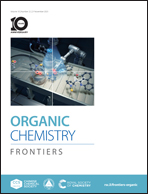Mechanistic study of CuH-catalyzed hydroarylation of alkenes with polyfluoroarenes involving C–F bond functionalization: noncovalent interaction-controlled regioselectivity†
Abstract
There is ongoing interest in catalysis with the earth-abundant metal copper (Cu). This density functional theory (DFT) study explores the detailed workings of the first CuH-catalyzed hydroarylation of alkenes with polyfluoroarenes involving C–F bond functionalization. The CuH complex undergoes Markovnikov hydrocupration with the aryl alkene substrate to give a Cu(I) benzyl intermediate, and the regioselectivity is due to a combination of orbital and dispersion interactions induced by the aryl alkene substrate. The benzyl ligand allows a 1,3-cupratropic shift for the Cu(I) complex to have an exposed carbonanionic atom facilitating nucleophilic aromatic substitution to the polyfluoroarene substrate. The distinct regioselectivity of para-C–F substitution is controlled by the noncovalent C(sp3)–H/π and C(sp2)–H⋯O interactions. These mechanistic insights can have implications for the development of new transition metal-catalyzed hydroarylation and C–F functionalization reactions.



 Please wait while we load your content...
Please wait while we load your content...